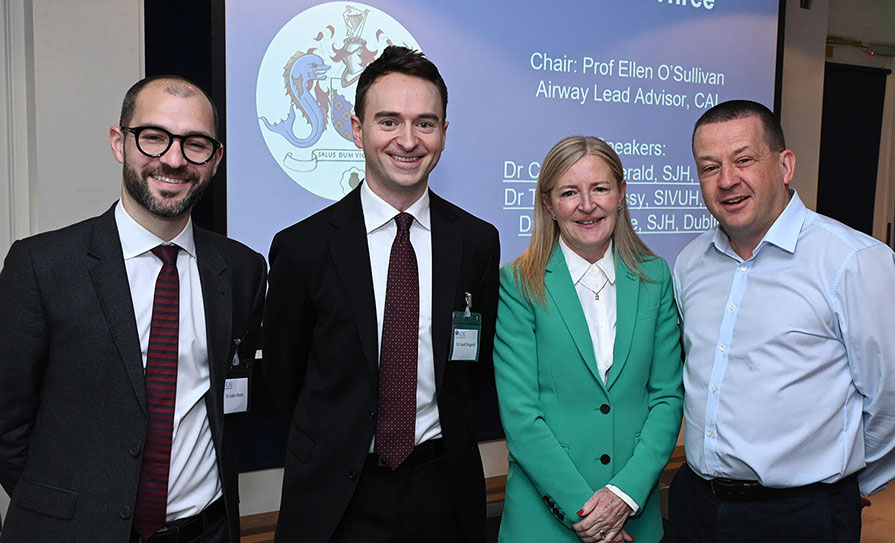Repeat electroencephalography (EEGs) are overused and uncommonly result in a change in electroclinical diagnosis, the Irish Neurological Association annual meeting heard. Speaking on behalf of members of the Department of Clinical Neurophysiology and Neurology at Our Lady’s Children’s Hospital, Crumlin, Ms Aisling McCarthy presented a study titled ‘Understanding the Value of Repeat EEG Testing in Children’.
Ms McCarthy, who was soon to graduate from her medical undergraduate course, explained that the research was a prospective, five-year outpatient study running from 2012 to 2017. The study analysed 4,162 consecutive outpatient EEGs and found that sleep was achieved in more than 93 per cent of cases and repeat tests were identified.
<img src=”../attachments/c2682834-2fa3-4db1-8b7c-0f58a2b299db.JPG” alt=”” />
<strong>Ms Aisling McCarthy</strong>
“The results of this study can be considered based on departmental activity and patient experience,” she told members of the audience.
Ms McCarthy added that one-in-four EEG studies carried out was a duplicate study and one-in-six patients attending for an EEG will have multiple EEG studies.
The primary role of EEG in children is the investigation of seizures, where it can assist in both the diagnosis and classification of different epileptic syndromes.
<h3 class=”subheadMIstyles”>Key observations</h3>
While EEG is useful in assessing childhood seizures, Ms McCarthy told the meeting that the team identified a number of key observations during their research. There is a high volume of requests for repeat EEGs, but most do not result in material diagnostic change or treatment modification. Furthermore, most of these repeat tests are requested without specifying any particular question. Indications for repeating routine EEGs in children are also not clearly defined in international guidelines.
“This can lead to overuse of the resource, wasted time for the patient and parent and health professionals involved. And most importantly, delayed access to EEG for those who need it more urgently,” she said.
While NICE guidelines recommend that early EEG be performed within six weeks of referral, the majority of centres in Ireland struggle to meet this recommendation.
“Seeing that there is rarely a diagnostic change on a repeat EEG, it is important to question the utility of repeat investigation, she added.
Citing Camfield et al’s 2000 study ‘How Often Does Routine Paediatric EEG Have an Important Unexpected Result?’, she said that if a test’s result is predictable, then the test may be unnecessary. She also highlighted an example of a repeat request where the EEG was asked to provide information that belongs in the collateral history.
But she stressed it is important to acknowledge that repeating an EEG is justifiable in certain cases where a change in the underlying diagnosis is not expected.
The aim of the study was to quantify the practice and pattern of repeat EEG requests and to analyse the outcomes of follow-up EEGs in relation to prior EEG study. The primary outcome measure was to identify how often a significant outcome change takes place.
“This was defined as a shift from an abnormal code or diagnosis to normal and vice-versa. We tried to identify factors that might predict when repeat EEG is most likely to produce change and thus would be of most clinical value,” she said. The team also tried to identify factors that might predict when repeat EEG is more likely to produce change.
Repeated studies were identified and these EEGs were outcome-coded by a single consultant reporter in a nine-point scheme that identified normal studies, non-epileptiform and epileptiform abnormal studies, and EEGs of uncertain clinical significance.
<h3 class=”subheadMIstyles”>Correlations</h3>
“A further subdivision of this scale identified detailed electro-clinical correlations, including infantile spasm,” she said. “If you are working in the neurophysiology lab, one-in-four of the EEGs you perform are duplicates. If you are a patient in the waiting room, you have a one-in-six chance of returning for a repeat exam.
“If you do return for a further study, 85 per cent of you will have one repeat study, or two in total.”
The most frequent interval for the repeated EEG is within the first six months of the previous one. The median interval is 12 months and the mean is 15 months.
In the majority of cases, the outcomes do not change with both focal and generalised epilepsy. She also highlighted the low rate of normalisation for juvenile myoclonic epilepsy (JME).
“There is an important clinical point here. Transient EEG normalisation can occur in JME; however, JME is regarded as a life-long or enduring seizure liability. So EEG normalisation is materially irrelevant, because it does not and should not alter the way epilepsy is managed in childhood.”
In terms of the normal studies (‘normal with certainty’, the other being ‘normal in all probability’), the key finding was that “definitely normal EEGs are highly likely to stay the same in repeat testing, whereas EEGs which showed a minor change but were otherwise within normal limits are more likely to become abnormal,” Ms McCarthy said. “If an EEG that is within normal limits becomes abnormal, it is most likely to show an epileptiform abnormality.”
<h3 class=”subheadMIstyles”>Duplicated EEGs</h3>
In terms of the overall value of repeating an outpatient EEG, the study looked at 555 duplicated EEGs. Only 15 per cent resulted in a consecutive change from normal to abnormal code, or vice-versa. There was an 11 per cent change from normal to abnormal and a 16 per cent change from abnormal to normal
“Based on this information, is it more helpful to repeat an EEG if the initial EEG is normal or abnormal?” she asked the audience. “It is more helpful to repeat a normal EEG, as chi square analysis shows that a higher proportion of normal EEGs become abnormal. In fact, a normal EEG is twice as likely to change to abnormal than vice-versa.”
Of the normal EEGs that become abnormal, the most common change is to an epileptiform abnormality.
“This provides justification for repeating EEG when suspicion of epilepsy is high, but the first EEG is normal.”
The overall rate of normalisation of repeat EEG in the time frame of this study is modest, at 24 per cent; broadly similar rates of normalisation are seen across the epilepsy groups, although the rates of normalisation are higher for focal rather than generalised epilepsy, as expected.
“We were surprised by the relatively high rates of normalisation of generalised infantile epilepsy, at 13 per cent. In general, these children have severe brain injuries and severe epilepsy, which persists into later childhood.”
Only one-in-five patients with a defined epilepsy syndrome normalised, whereas two-in-five with non-epileptiform or unclassifiable epileptiform abnormalities showed normalisation on EEG, the study found.
<h3 class=”subheadMIstyles”>‘Significant’</h3>
“This is significant as it calls into question the utility of the repeat EEGs in many of these defined epilepsy syndromes. If an EEG is unlikely to change, then it is unlikely to guide management or provide new information. Again, if the test is predictable, then the test may be unnecessary.”
The study also found that 38 per cent of non-epileptiform or unclassifiable epileptic abnormalities normalise, whereas only 20 per cent of specified epileptic abnormalities normalise.
The study concluded that EEG is a valuable resource in the investigation of childhood epilepsy but guidelines on indications for repeat EEG are lacking, which is contributing to EEG overuse.
It is more useful to repeat a normal EEG than an abnormal EEG, especially when the suspicion is high. Abnormal EEGs normalise less frequently than normal EEGs, with the lowest rates of normalisation seen in infantile spasm and JME.
“Based on this study, we found more utility in repeating a normal EEG when the suspicion of epilepsy is high, compared to an abnormal EEG, as a normal EEG is twice as likely to change to abnormal than vice-versa,” Ms McCarthy said.
<h3 class=”subheadMIstyles”>Take-home message</h3>
“The take-home message of this study is, when requesting EEG, recognise that the rates of significant change are low and that you should have a clear clinical question to be answered.”
She hoped that the study would lead to more research on the indications for repeat EEGs on children and contribute to the development of guidelines on appropriate EEG referral.
During the questions and answers section, it was asked why repeat tests for abnormal results were being ordered.
“A lot of the time, people are referring in to show that the EEG is normal if the patient is seizure-free for two years and off medication, and that shouldn’t happen. And that’s why we think there needs to be guidelines on this to stop that kind of inappropriate referral burdening the service.”
It was also mentioned during the Q&A that patients with IGE [idiopathic generalised epilepsy] and whose symptoms may be subtle could be a reason to repeat an EEG in someone where the diagnosis is established.










Leave a Reply
You must be logged in to post a comment.